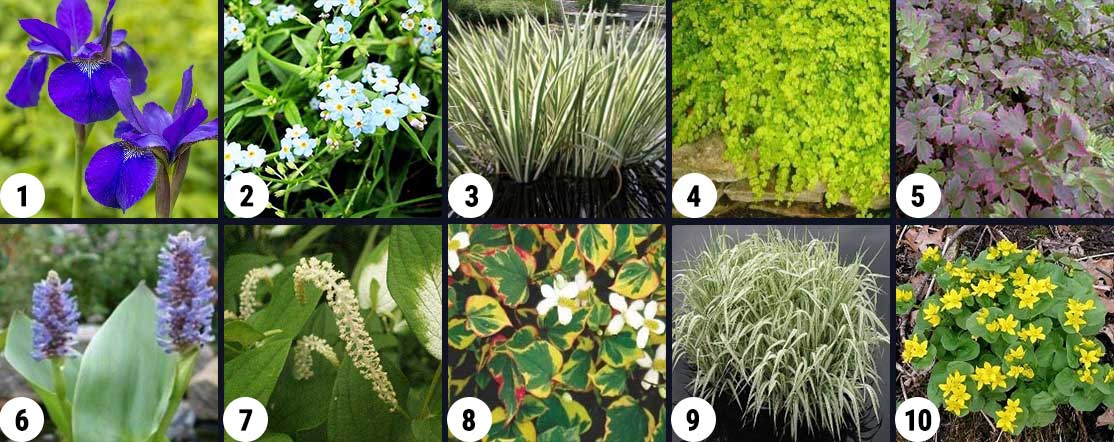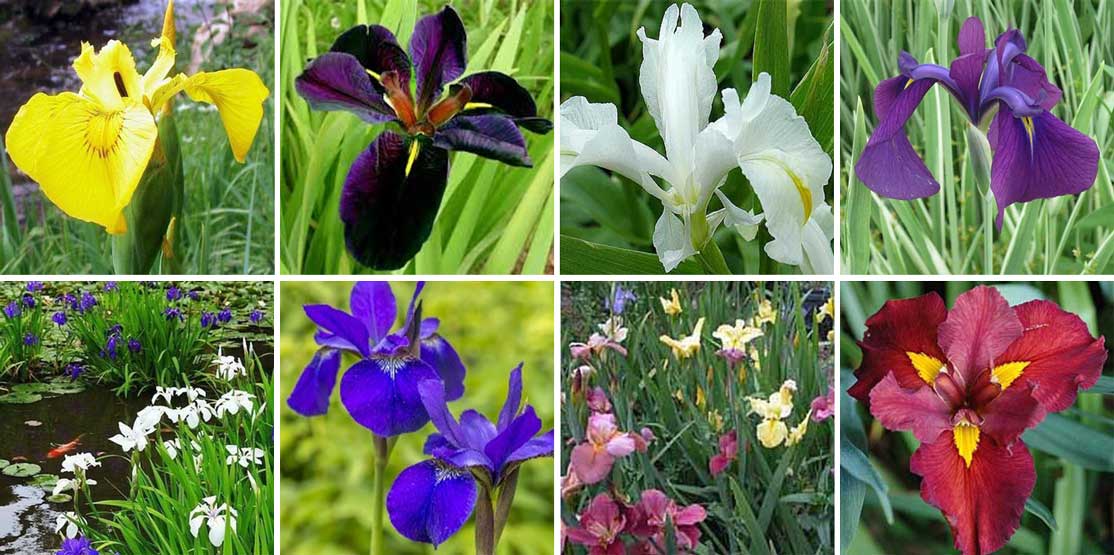Best Hardy Marginal Pond Plants for Filtration
Filtration plays an important role in the health of your pond water. Did you know that many pond plants help naturally filter your pond water? Follow along as we cover the top 10 hardy marginal pond plants that will help with your pond filtration.

10. Marsh Marigold (Caltha palustris)
A lush, mounding perennial with broad, heart-shaped leaves. It grows to a height of one to two feet tall producing large, buttercup shaped, yellow flowers. It is one of the first pond plants to bloom in the spring and re-blooms in the fall when water temperatures start to cool off. It is prolific in cooler temps and tends to die back in the heat of the summer. Because of its limited seasonal presence, we had to put it at number ten. But keep in mind, it goes to work and starts filtering while the other pond plants may still be sleeping.
On the plus side, it is typically both the first and last to bloom in your pond!
9. Manna Grass (Glyceria maxima)
A short perennial reed, also known as sweetgrass, grows well in damp to saturated areas. Although it grows and spreads rapidly, it is easy to control with a little maintenance. It will offer a thick, soft, flowing mound when given a “hair cut” as it starts to get lanky.
Left to its own devises, it will lay on the water and form floating mats of roots with blades of grass popping up now and again.
8. Houttuynia (Chameleon Plant)
An attractive, but often aggressive, ground cover that is easier to control in a pond than it is in a landscape. Tolerates shade as well as full sun, but expresses more vibrant color in the sun. It grows heart shaped leaves with distinct yellow and green variegation and bright red edges. Small white flowers, resembling strawberry blossoms, appear in the spring. If care is taken to cut back longer stems of the plant, it will stimulate new growth making it full and mounding.
*Be careful not to let stems fall outside of the pond. I would not recommend putting them in your compost pile. Even the cut shoots will root and take over.
7. Chinese Lizard Tail (Saururus chinensis)
This plant is named for the bottle brush type flower’s resemblance to a lizard’s tail. It is native to China, India, Japan, Korea, Philippines and Vietnam. It’s been used as a medicinal herb in those places for decades. Grows to be 24-36” tall if left to grow wild and will adapt to being planted in water even a foot deep.
6. Pickerel Rush (Pontederia cordata)
Native to North America, pickerel rush, (or pickerel reed) is a very tall marginal. (I’ve seen it get 4-5’ tall, but not normally.) Features large dark green leaves and tiny blue, white or pink flowers on a single spike. It prefers shallow, quiet water and is attractive to hungry deer.
5. Rainbow Water Celery (Oenanthe javanica ‘Flamingo’)
A delightful marginal plant, grown for its pretty variegated foliage, which brings color to ponds as early as March. Leaves have pink and cream margins, which perfectly complement its small white summer flowers.
*It can be an aggressive grower and will be happy to jump out of the pond to be a ground cover if you let it. Keep it trimmed and you will get a thick beautiful plant that fills in the cracks between rocks along the edges of the pond and in the streambed.
4. Golden Creeping Jenny (Lysimachia nummularia ‘Aurea’)
Commonly sold as a low growing ground cover, or an ornamental plant, for its striking yellow (golden) leaves and trailing habit. Will tolerate shade as well as sun, but will show brighter color in full sunlight. Easy to propagate by pinching off stems and placing them in shallow moving water.
Beautiful in bogs and streams, or growing over the edges of a floating island or hanging down rock walls of a waterfall.
3. Sweet Flag (Acorus calamus)
This pond plant has leaves that closely resemble the Iris. It grows well in water 12-18” deep, in a bog filter and anywhere in between. Sweet Flag can be distinguished from Iris by the crimped or ruffled edges on the leaf, the fragrant “citrus” odor it emits when crushed and the unusually tiny “corn cob” looking “flower.”
It spreads quickly and is easy to transplant. The rhizome it spreads on may have many sections of upright growth with roots underneath. Each section may be separated and tucked under a stone to replant.
2. Forget-Me-Nots (Myosotis Scorpioides)
This is a low-growing plant that, if planted in an area of moving water, can grow mats of fibrous roots great for filtering pond water. These root masses resemble filter pads sometimes found inside of the bio-falls or pond skimmer. Tiny blue flowers with yellow centers spring above small green foliage for almost the entire ponding season.
It can be planted along the edges of the pond to soften the rocks, in a bog, in the stream or on a floating island. It is very easy to transplant – just cut a mass with roots in tact and set in the desired area, place a little gravel on top to hold it in place and it will take off!
Occasional trimming will keep it full and tidy looking after it blooms. Thrives in full sun to part shade.
1. Water Iris
The varieties of Iris are numerous, which is what makes this plant our number one choice - besides the massive root system that develops in a pond, of course.
Iris can grow in water depths of 2’, as well as the flower beds outside of the pond. Its leaves grow tall and stately like a broad sword. They may be all green, or striped long ways with green and white or a green and creamy yellow. The flowers produced in the spring can be found in a delightful array of colors like white, blue, red, yellow and various shades of purple; with or without other colors mixed in.
They are just as easy to split and transplant as sweet flag.

Hoffman’s Water X Scapes offers one of the largest selection of aquatic pond plants in North East Ohio. Visit us in Uniontown Ohio and walk through our beautiful green house to see them all. You can check out our Pond Plants online – but keep in mind we have more available at our Garden Center store front. At this time we only ship hornwort, water lettuce, and water hyacinth.
